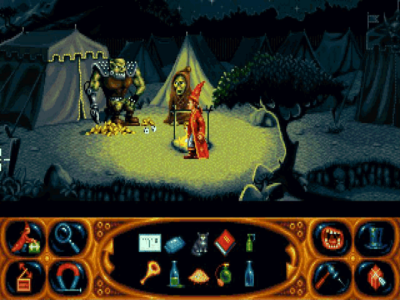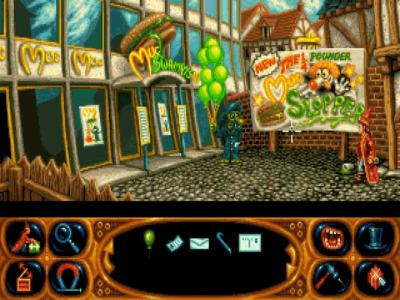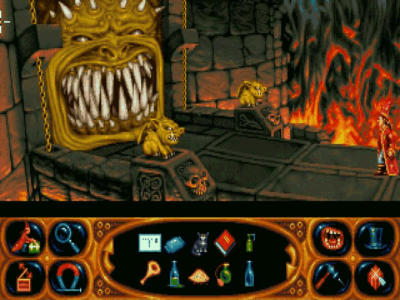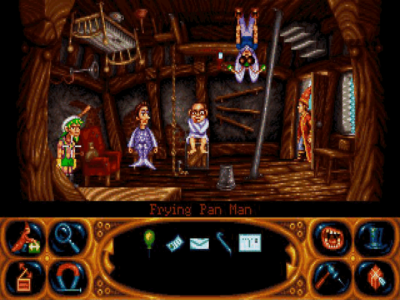
Simon the Sorcerer II: The Lion, The Wizard and the Wardrobe
Written by: Jo
Date posted: March 9, 2008
- Genre: Adventure
- Developed by: Adventuresoft
- Published by: Adventuresoft
- Year released: 1995
- Our score: 8
It was only a matter of time before I reappeared with a review of the second instalment of Simon the Sorcerer. In truth, the sequel strikes a chord with me more than the first. That seems to happen a lot with sequels, they can either be alarmingly unfaithful to their predecessor and somehow everything gets a bit lost and tangled up, or, alternatively they take everything that’s great about the original, and make it better. And personally, I think that’s what happened here…
The first game leaves Simon back in his own dimension, Sordid has been dealt with and the ever-fumbling wizard Calypso is safely back in situ. As far as we were concerned, I guess, they could have left it at that. I always wonder at the end of a video game or film whether or not to expect a sequel, and if so, where can it pick up from? Good question, and only the fantasy genre can bring a baddie back from the dead, time and time again, and still have them reap revenge on the world (or in this case, another dimension). I’d rather have comical baddies returning LeChuck-style rather than having random baddies, appearing from nowhere, picking fights they have no part in. No, I’m not bitter about the extensive use of villains in the latest Spider-Man movie. Not at all.
Anyway, the return of Sordid is brought about entirely at the hands of a snivelling little runt, named, er, ‘Runt’, who rebels against his father’s wishes for him to work on the farm and instead starts dabbling with magic. During a typical angsty row with Papa, Runt’s reading material (which happens to be Sordid’s old magic book) is burned and thrown aside, thus beckoning the old Sorcerer from his troubled grave. And so it begins. Sordid returns in ghost form, taking Runt under his wing as his new apprentice. After (quickly) constructing a ‘Fortress of Doom’ Sordid introduces his plan to retrieve Simon by using a Wardrobe – which is actually a magical transportation device for crossing dimensions, a handy thing to have when you’re nemesis is residing in a different dimension, I guess.
One thing leads to another, and Simon reappears in the other world once again, although not according to Sordid’s evil plan. Instead he turns up elsewhere in the presence of doddering wizard Calypso and his slightly top heavy niece Alix. So, now it’s up to Simon to get home, all he needs is to track down some Mucasade to create the 1.5 gigawatts of energy to get the Wardrobe moving again. Apparently it’s pretty rare stuff to get hold of, and so the quest begins. Phew – quite a long intro there, but the story is already in full motion, and we as the player are keen to find out how things are going to unfold. While Simon has no idea why he’s been brought back to the other dimension, Sordid certainly does, and sets out to hunt him down.
I guess this is what’s great about well-made sequels. The heroes and the villains are already set up, they’ve already got a bone to pick, and it’s merely about the way they’re going to pick it. This game, despite being made in pretty much the same style as its predecessor, seems considerably different somehow. I’m not sure if it’s largely down to the abandoning of the quite classic Lord of the GODDAMN Rings fantasy set-up and moving towards a more contemporary approach a la Terry Pratchett. It somehow makes the game less restricted and gives it the ability to be nicely self-aware without excluding those who aren’t fans of the genre. It’s very approachable, and somehow, a lot less brown…
Unlike the original, Simon isn’t confined to one location throughout the game. As with Monkey Island, Simon can move around a large area via a map. In contrast with the previous game, the map automatically appears as soon as Simon leaves a particular setting. This method seems to work so much more fluidly than the whole ‘exploring’ bit, which got a little tedious and frustrating last time around. It’s not just the use of the map that makes the setting less confined, and as you progress through the game more locations are introduced, including a pirate ship and a tropical island. This works so well in a point and click game, and while the story is still linear, it’s not in an overly obvious, drudging progressive type manner, instead striking a good balance between moving gradually through the story and the ‘oh what the bollocks am I supposed to be doing’ type feeling.
One of the failings of the first game was that Simon spent about the first 90% of the game trying to become a Wizard, and then there was something about saving Calypso tacked on at the end, roll credits. Thankfully that’s not so much the case here. The story unfolds in parallels, in that on the one hand we’ve got Simon, who’s merely trying to get home to normalcy, and on the other we’ve got Sordid ghostly evil-doer just, well, trying to get reincarnated. The issue is all greatly helped by the ability to progress to different places in the game, and each place being entirely different from the last, and in general the narrative unfolds nicely and continues to intrigue.
Earlier I’d said that most of the main characters from the previous game had returned in pretty much the same guise as before, but one thing you might notice (almost straight away) is the absence of Arnold Rimmer, sorry, Chris Barrie, with his voice being replaced by that of someone considerably more poncy and smug. A couple of people told me that because this changed they came to resent Simon as a protagonist, seeing as he was far too smarmy, but I’m not sure I agree. In fact, I almost like him fractionally more, for being almost entirely self-aware and sarcastic – staying true to pretty much the overall feel of the game.
I’ve already mentioned Calypso and Sordid (who incidentally sounds like a reject from EastEnders), but also making a reappearance is Swampling, that green thing that whinges and makes you eat mud from the first game. We’re introduced to considerably more characters as the game progresses, which on the whole makes the game a lot less empty and lonely as it tended to be first time around. The interaction amongst characters, again, makes it less goblins and gollums (or whatever the hell they are) and more weirdos, freaks and geeks from start to finish. Most of the time you’ve got to help said people, whether it’s assisting with the formation of a rain dance to some poor chap named after a popular 1980’s kids drink (he really is called ‘Um Bongo’) or persuading a train-spotting geek (who’s recently lost his Unix manual) to toughen his image up.
As you’d expect, later in the game we meet more goblins and witches and gnomes (or whatever), once you begin approaching Sordid’s fortress of doom. It just wouldn’t be right if the sequel almost entirely abandoned its roots, and killed off the world it had created in the first game. So the latter half of the game reintroduces the dark, more traditional fantasy world that was so familiar originally. As for playability, I really can’t stress enough how much more enjoyable it is than the first. The story has considerably more purpose: curiosity plays a big part (especially for Simon), and it feels like the story is actually heading somewhere.
I won’t deny that the sequel has its moments of being entirely tedious. As a considerably laid back gamer, I grind my teeth anytime I have to pick up a pen and make a note of something. There’s a substantially annoying bit where you have to explain the nonsense currency system to an ironmonger (whose dreadful Yorkshire accent seems somewhat reminiscent of Ted Glenn from Postman Pat) struggling with his tax return. The castle guards cheerfully explain the currency for you, but it’s a pain to get down on paper in any short space of time. And then you actually have to figure out the answers to the ironmonger’s questions. It’s too maths orientated for my liking (maths is up there with Lord of the Rings on my list of pet hates). On the whole though, it’s your bog standard adventure logic type stuff, all you’d expect from an adventure game I guess.
So, to conclude, it’s a fun, well-rounded adventure that embraces an entirely self-aware humour that fantasy-lovers and cynics alike will enjoy. Just don’t be too disappointed by the ending (or the fact that the third game took 10,000 years to make, and when it finally turned up everyone had lost interest).






 Posts
Posts